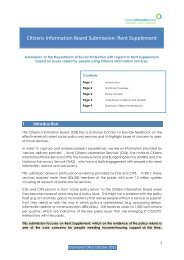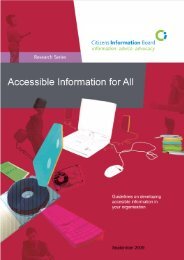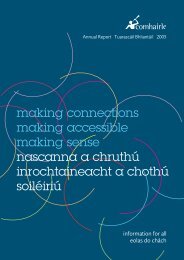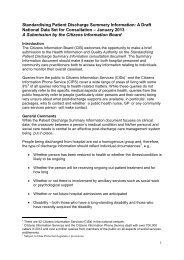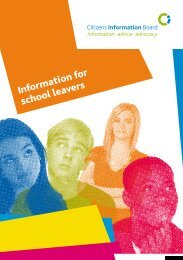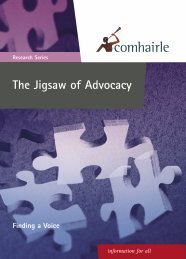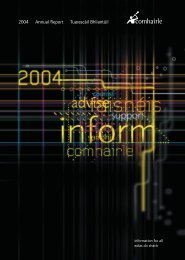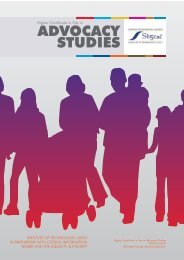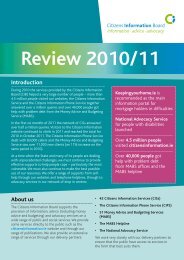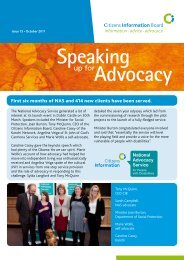Review of Sign Language Interpretation Services and Service ...
Review of Sign Language Interpretation Services and Service ...
Review of Sign Language Interpretation Services and Service ...
- No tags were found...
You also want an ePaper? Increase the reach of your titles
YUMPU automatically turns print PDFs into web optimized ePapers that Google loves.
<strong>Sign</strong>ificant, has also been contracted to provide remote interpreting services forNHS Direct, which provides information in response to medical queries via thetelephone. Funding for this initiative has come from the Department <strong>of</strong> Health.This project only began on 1st January 2005 <strong>and</strong> there has, to date, been noevaluation <strong>of</strong> the service. The intention is for BSL/English interpreters to beavailable via videophone or videoconference to interpret between NHS Directstaff <strong>and</strong> Deaf people within an hour <strong>of</strong> a request being made. The scheme alsopromotes the purchase <strong>of</strong> videophone equipment by Deaf people, beginning at acost <strong>of</strong> approximately €293, although the user also needs to have a subscriptionto broadb<strong>and</strong> (at approximately €36 a month).Another example <strong>of</strong> video relay developments is taken from the United Stateswhere the RID (Registry <strong>of</strong> Interpreters <strong>of</strong> the Deaf) has a draft paper on itswebsite for consultation on ‘Emerging Video Interpreting <strong>and</strong> Video Relay:St<strong>and</strong>ards <strong>and</strong> Regulations (Draft)’ detailing required training, working conditions,legal considerations <strong>and</strong> FAQs. America has a Federal Relay <strong>Service</strong> whichprovides voice to text <strong>and</strong> also videophone <strong>and</strong> online calls to federal <strong>and</strong>military employees.The United States is at an advanced stage in the development <strong>and</strong> rollout <strong>of</strong> avideo relay service, with the US government providing financial support for theservice. The Americans with Disabilities Act requires large telecommunicationscompanies to pay a percentage <strong>of</strong> their income to a relay fund, which is managed<strong>and</strong> administered by the Federal Communications Commission (a not for pr<strong>of</strong>itorganisation).The US government does not cover the cost <strong>of</strong> the videophone equipment. Many<strong>of</strong> the telecommunications companies have arrangements whereby they providethe videophones to the customers at no cost, on the basis that they will remain acustomer <strong>of</strong> the organisation <strong>and</strong> continue using its services.3G technology has been used to support mobile videophone technology. Thequality <strong>of</strong> the image is a constraining factor at present, but there are models on themarket which have managed to significantly increase the quality <strong>of</strong> the image,thereby enabling Deaf-to-Deaf <strong>and</strong> Deaf-to-hearing video conferencing. Forexample, in Sweden a 3G model exists which is very high quality <strong>and</strong> can be useddirectly between two sign language users, signing back <strong>and</strong> forth to one another.Another example, <strong>of</strong> a video interpreting system, is the Accessible RemoteInterpreting Project, which was run by the Finnish Association <strong>of</strong> the Deaf from2002 to 2004. Funded by the national lottery, the project <strong>of</strong>fered remoteinterpreting from the <strong>of</strong>fice headquarters in Helsinki. There were designated dutyhours four days a week, <strong>and</strong> outside <strong>of</strong> these hours, an interpreter could bebooked in advance.Most <strong>of</strong> the calls were to interpret telephone conversations between a hearingperson using a telephone <strong>and</strong> a Deaf person signing via a videophone. At the end<strong>of</strong> the project, 31 Deaf people had used the service from 12 local regions. Theservice continues to be run by the Finnish Association <strong>of</strong> the Deaf, who cite thefollowing advantages <strong>of</strong> the service:<strong>Review</strong> <strong>of</strong> <strong>Sign</strong> <strong>Language</strong> <strong>Interpretation</strong> <strong><strong>Service</strong>s</strong> <strong>and</strong> <strong>Service</strong> Requirements in Irel<strong>and</strong> • page 97



